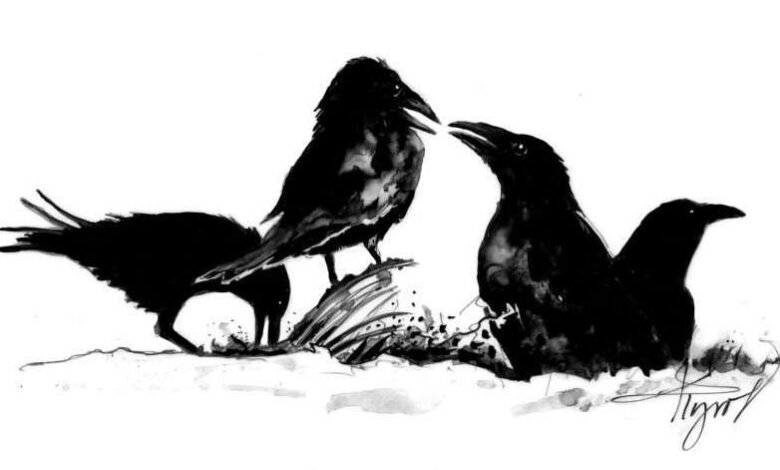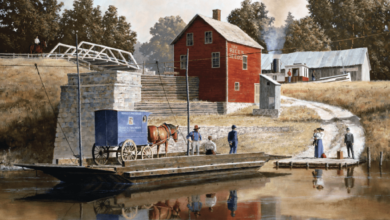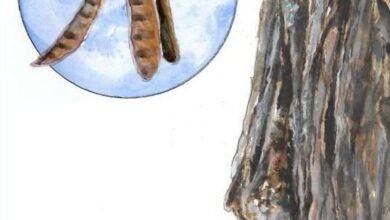Ravens Foraging in Winter – New York Almanack


 It’s a familiar sight in winter: An inky-black raven soaring over a landscape white with snow.
It’s a familiar sight in winter: An inky-black raven soaring over a landscape white with snow.
Though similar in appearance to the American crow, the common raven (Corvus corax) is distinguished by its large size, fluffy neck feathers, and long, thick beak.
The ubiquitous raven croak can carry for more than a mile. It is throaty and rasping, unlike the American crow’s shrill caw.
While the croak is the most recognizable call that ravens use, it’s far from the only one. These intelligent birds can make 33 different vocalizations, which express a whole range of meanings such as deterring a predator, defending a nest, or communicating the presence of food.
Scientists at the University of Vienna in Austria concluded that ravens may even have theory of mind, meaning they’re aware of both their own and others’ thoughts, motivations, and behaviors.
A raven’s intellect is essential in winter when insects, bird eggs, berries, and other desirable foods are scarce. Ravens must be dogged in pursuit of the calories they need to make it to spring.
“Right now, they are trying to pack on protein and fat,” said Anna Morris, director of wildlife ambassador programs at the Vermont Institute of Natural Science, where she works with an ambassador raven named Stockbridge.
A raven is unlikely to turn up its nose at any opportunity to eat in winter. They’re regulars at compost piles and garbage cans. “You see them a lot in urban areas this time of year,” said Kevin Tolan, staff biologist at the Vermont Center for Ecostudies.
Carcasses, including those of animals killed by cars, illness, or injury, are prized resources in winter.
The carcass of a dead male white-tailed deer, for example, could offer more than 200 pounds of meat and fat — some of which a raven could store for leaner times in a hidden reserve called a “cache.”
The trouble is, there’s no telling where a raven may come across a carcass, and odds are it could be in another raven’s territory.
Adult ravens live monogamously in pairs, defending their territory from incursions by predators and other ravens, usually “vagrants” without their own territory.
Juvenile vagrants work together to make it through the lean months. “You get these roving bands of teenaged ravens who are looking to exploit large ephemeral food sources, such as carcasses,” Morris explained.
Young ravens puzzle through their first winter without the help of a mate and develop some wily tricks to make it through, as first documented by biologist Bernd Heinrich, professor emeritus at University of Vermont.
Heinrich observed ravens emitting a loud yell at the site of carcasses — attracting their peers to join in on the meal.
Over the course of four winters, as described in his book Ravens in Winter, Heinrich set carcass baits and observed the ravens’ behavior at them to see whether they were indeed communicating the whereabouts of food to their peers.
Paired ravens, Heinrich found, didn’t yell when feeding. In fact, 82 of the 91 ravens who arrived at the baits for four separate group feasts were either non-breeding juveniles or sub-adults.
“The paired ravens are fully grown adults,” Morris said. “They’ve been through multiple seasons together. They’re a little bit more savvy about gathering food and food resources.”
Heinrich’s study showed that group feasting is a young raven’s game. The birds attracted to the carcasses were primarily juveniles without their own territory who, in surveillance flights, had successfully found a meal ticket.
They understood that it was a risk to eat in another raven’s neck of the woods, so they called in back-up.
“All these ravens show up together at this food resource, they make a bunch of noise, they attract other ravens, and therefore the group can overwhelm the defensive territorial pair,” Morris explained.
This practice means that each teenage raven gets less to eat at any shared food resource. “If you have to share your birthday cake with your 15 neighbors, you’re going to get less of it yourself,” Morris said.
But for birds who are still learning the art of foraging in winter — and who can’t yet rely on the help of a mate or the known resources of their own territory — it’s worth it.
Read more about birds in New York State.
Emily Haynes is a writer currently living in Washington, D.C. An avid birder and hiker, she loves exploring the forests of the Northeast. Illustration by Adelaide Murphy Tyrol. The Outside Story is assigned and edited by Northern Woodlands magazine and sponsored by the Wellborn Ecology Fund of New Hampshire Charitable Foundation: nhcf.org.
Source link





